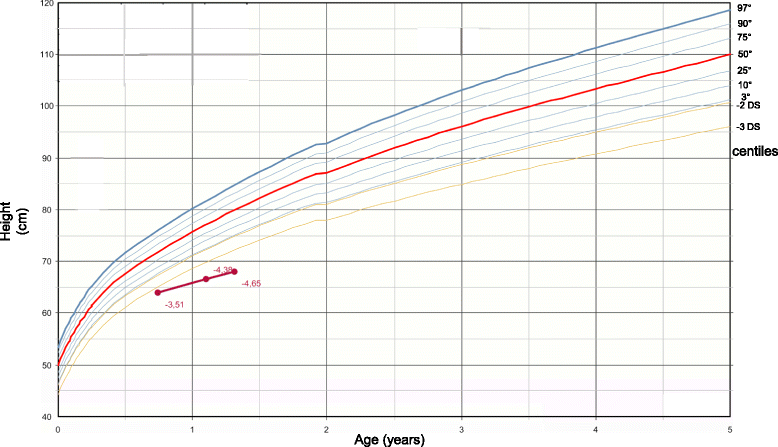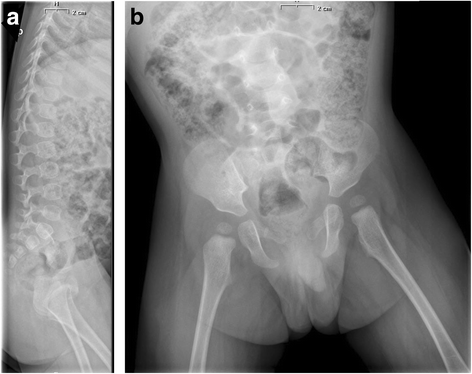Short stature: an ordinary sign for an unordinary diagnosis
- PMID: 28754141
- PMCID: PMC5534101
- DOI: 10.1186/s13052-017-0381-9
Short stature: an ordinary sign for an unordinary diagnosis
Abstract
Background: Short stature (SS) is a relatively early sign of poor health. Only in 5% of cases we can explain it through the presence of endocrinological pathologies. Therefore, if SS is present since the first months of life, it is necessary to investigate all systemic disorders with secondary effects on growth.
Case presentation: We report the case of a 16-months-old male infant with severe SS apparently not associated with other clinical signs or symptoms. The patient arrived to our attention after he was hospitalized for an Echovirus enteritis, associated to moderate neutropenia (800/mm3) and hypertransaminasemia (AST 116 U/L, ALT 88 U/L) at the age of 13 months. SS was detected in that occasion. Since SS persisted even after the complete resolution of enteritis symptoms, he was taken care by our unit.
Conclusions: SS appeared in the first months of life and associated with moderate neutropenia and hypertransaminasemia led us to the diagnosis of Shwachmann-Diamond syndrome. We recommend paying further attention to this condition during the differential diagnosis of children with severe SS.
Keywords: Growth retardation; Hypertransaminasemia; Neutropenia; Short stature; Shwachmann-Diamond syndrome.
Conflict of interest statement
Ethics approval and consent to participate
The study was conducted in compliance with the terms of the Helsinki II Declaration and written informed consent for the enrolment and for the publication of individual clinical details was obtained from parents. In our country, namely Italy, this type of clinical study does not require Institutional Review Board/Institutional Ethics Committee approval to publish the results.
Consent for publication
The authors have obtained consent to publish from the parent of the children.
Competing interests
The authors declare that there are no competing interests that could be perceived as prejudicing the impartiality of the affirmation reported.
Publisher’s Note
Springer Nature remains neutral with regard to jurisdictional claims in published maps and institutional affiliations.
Figures
Similar articles
-
Short stature as a presenting symptom of attenuated Mucopolysaccharidosis type I: case report and clinical insights.BMC Endocr Disord. 2018 Nov 12;18(1):83. doi: 10.1186/s12902-018-0311-x. BMC Endocr Disord. 2018. PMID: 30419879 Free PMC article.
-
[Psychiatric manifestations of lupus erythematosus systemic and Sjogren's syndrome].Encephale. 2001 Nov-Dec;27(6):588-99. Encephale. 2001. PMID: 11865567 French.
-
Factors that contribute to hypertransaminasemia in patients with celiac disease or functional gastrointestinal syndromes.Clin Gastroenterol Hepatol. 2014 May;12(5):804-810.e2. doi: 10.1016/j.cgh.2013.10.033. Epub 2013 Nov 7. Clin Gastroenterol Hepatol. 2014. PMID: 24211290
-
Children with short-limbed short stature in pediatric endocrinological services in Japan.Pediatr Int. 2014 Dec;56(6):809-812. doi: 10.1111/ped.12511. Epub 2014 Nov 28. Pediatr Int. 2014. PMID: 25244068 Review.
-
Pseudoachondroplastic dysplasia.J Postgrad Med. 1993 Apr-Jun;39(2):91-3. J Postgrad Med. 1993. PMID: 8169872 Review.
References
-
- Myers KC, Bolyard AA, Otto B, Wong TE, Jones AT, Harris RE, Davies SM, Dale DC, Shimamura A. Variable clinical presentation of Shwachman-diamond syndrome: update from the north American Shwachman-diamond syndrome registry. J Pediatr. 2014;164:866–870. doi: 10.1016/j.jpeds.2013.11.039. - DOI - PMC - PubMed
-
- Kucuk O, Ugras M, Bicer S, Col D, Giray T, Erdag GC, Yalvaç Z, Kaspar C, Vitrinel A. Hypertransaminasaemia in children with viral gastroenteritis. Infez Med. 2016;24:32–37. - PubMed
Publication types
MeSH terms
Substances
LinkOut - more resources
Full Text Sources
Other Literature Sources
Medical



